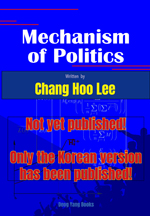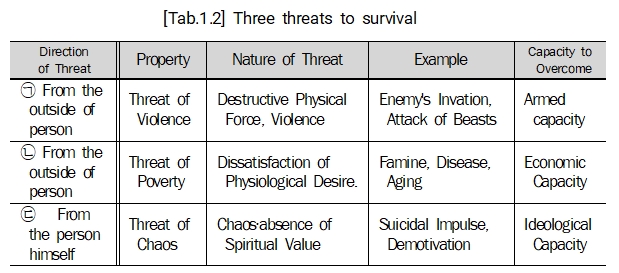| |
Chapter 1. Basic Principles
of Political Phenomena

A. General Principles of Political
Phenomena
(2) Three Aspects of Survival
Directivity
b. Three threats to survival and Samjae
capacities
The survival directivity of humans
is manifested as activities that eliminate specific
threats to survival. Then, how can we classify the
threats to human survival? I will divide the threats
into three categories. Threats to survival in other
areas appear to be logically impossible.

Threat of violence
Let me call the first category of
threats 'threat of violence'. Threat of violence includes
threats from wild beasts, threats of foreign invasion,
and threats of robbery. Why can we call threat of
violence a threat from the outside? It is because
violent threats are generally caused by other phenomena
outside the actor of survival. This is true for threats
from a wild beast, a kidnapper, and an outsider. They
are generally threats from other living beings or
other humans.
The threat of violence has always
been present in political situations. It is easy to
have the illusion that there is no war or threat of
violence in primitive small-scale societies. However,
according to research conducted by hundreds of anthropologists
over several decades, the probability of death caused
by violence in primitive small-scale societies was
astonishingly high. Keeley said, when societies are
not separated from other societies by natural environments,
70-90% of band or tribal societies have had wars in
the last five years, and huntinggathering groups such
as the !Kung or the Canadian Coeur d'Alene had a four
times higher murder rate than the average in the United
States when they maintain their own social forms.
Threat of violence that is large-scale
is called war. According to Heinrich von Trotsche,
peace is merely blank pages in history books and there
have been countless wars all over the world. American
anthropologist Harry Turney-High consistently argues
that, excluding exceptional cases, wars have been
a universal human activity throughout all times.
The threat of violence is intense
and briefly interrupts survival in a way that cannot
be recovered, so a tool to prevent this is necessary
for survival. That is military power. A nation must
have military power to control wars in order to maintain
itself. Rome was able to be maintained due to its
strong military power and the Goguryeo, which flourished
and developed until the late 3rd century, was also
referred to as a complex armed force centered around
"Iron Warriors" and won victories in battles
such as the conquest of Seonbi states and the battles
with China. This was thanks to its strong military
capability, which can be seen from the examples of
victory. Medieval European cities, which were independent
political organizations, also grew as they were close
to trade routes and had facilities to protect merchants.
Threat of poverty
Let me refer to the threats in the
second category as the "threat of poverty".
The threat of poverty includes threats arising from
human biological conditions such as hunger and disease,
as well as threats to survival that come from not
being able to satisfy various human desires. These
threats are intrinsically rooted in a deficiency of
goods, that is, they originate from poverty.
The reason for explaining the threat
of poverty as a threat from within the human being
is because it is a threat that arises from within
the life phenomenon of the human individual. If a
person lives in a safe place, over time, threats to
survival such as hunger, thirst, disease, and aging
will arise. These are all threats that arise from
within the human being. Hunger arises as a threat
because the human body constantly consumes energy,
and thirst is similar. Also, diseases generally occur
because the immune system's ability to resist pathogens
from within and outside the body weakens.
Threats of poverty such as hunger,
disease, aging, and thirst are not immediate, and
therefore, do not threaten survival in a short amount
of time. Therefore, they slowly appear and are gradually
solved. For example, hunger is not faced during drought
or flood, but begins around winter of a year when
crops are damaged by drought or flood. And the complete
resolution of hunger is only possible when the next
year's farming is abundant. Diseases are also similar.
In that sense, the threat of poverty may be a consideration
that is less urgent than the threat of violence.
What is needed to prevent the threat
of poverty is economic power (i.e. economic capacity).
This includes the direct possession of goods such
as food and clothing, but also the ability to produce
such goods. Because the threat of poverty motivates
people in the medium or long term, any individual
or force can mobilize many people with this economic
capacity. They gain social influence.
Threat of chaos
The third category of threats is
the "threat of chaos". These include wrong
values, doubts about life, mental illness, suicide
impulses, and powerlessness. The reason why this is
called the "threat of chaos" is because
the core of these threats is "chaos", such
as mental confusion, contradictions in values, and
loss of life's purpose. Although "confusion of
values" or "mental confusion" are the
essence of such threats, why are they not referred
to as "threat of values" or "threat
of mind"? This is because the problem is not
the action of ideology or mind itself, but the confusion
contained in it that is the source of the threat.
Such confusion of values and mental
confusion can lead people to choose death not by others,
but by themselves. For example, when a rapid change
in an individual's social position or a massive change
in wealth, or divorce, leads to the collapse of a
familiar world, suicidal tendencies emerge. Similarly,
when moral forces that form the foundation of society
lose power, the political order collapses at the hands
of the violent crowd, which is a threat of social
chaos.
It is clear that the threat from
this chaos is not a threat from outside of humanity.
On the other hand, one could argue that the direction
in which this threat is appearing is not "the
self of humanity" but "the inside of humanity."
However, if I use terms such as "outside"
or "inside" here to refer to spatial positioning,
I can say that the threat of chaos originates from
the human being themselves. Furthermore, due to this
distinction, a place is also created where the threat
of poverty can be placed differently from the threat
of violence.
Threats from within the human themselves may appear
to be less important because they are not sensed in
a sensory manner compared to threats from violence
or poverty. In particular, this may seem to have less
influence in the eyes of society and social sciences
as it is just a matter of concern for philosophers.
However, as a Korean economist has said, "A human
cannot survive without the minimum necessities of
food, clothing, and shelter, but at the same time,
they cannot live solely on those necessities."
In order to prevent such confusion,
it is necessary to use the ideological power that
influences people's behavior, that is, the ideological
capacity. Religion can be a representative example.
In an era when religion had a stronger cultural influence
than today, the suicide of the elderly with religion
was rare. In the late 1640s, the people who built
the first European settlement in the New England region
of America in Plymouth in 1608 lived in poverty with
nothing but a struggle, but were satisfied with religious
freedom. Today, religion still plays a role in preventing
the suicides of the elderly, who prefer death over
loneliness, chronic illness, and dependence. In addition
to religion, philosophical and cultural elements that
influence people's behavior can also be included in
such ideological capacity.
To summarize the above content, it
can be said as follows.
| |
[Ch.1.2] (Principle
of Samjae Capacity) Threats to human survival
come from outside, inside, and from the human
themselves. To overcome this, humans need three
capacities (Samjae capacity). |
The principle of the Samjae capacities
is often accurately applied to events that occur in
actual political reality. For example, if we look
at the coup d'etat in Thailand that occurred on June
24, 1932, the main causes of the coup, led by Phibun
Sonkram and Pridi Phanmyong, were: ¨ç the threat to
the military's interests, ¨è the worsening of economic
conditions due to the incapacity of the Thai monarchy,
and ¨é the elite class's critical attitude towards
the absolute monarchy.
<Every footnote was
deleted from the book>
  
|